Indoor plant sansevier: all about growing
There is a certain category of flower growers who enjoy cultivating evergreens such as the sansevier. It is distinguished by an unpretentious disposition, an interesting appearance, as well as bright greenery. Those who decide to decorate their home with an exotic pet are advised to familiarize themselves with the main rules of growing - watering, temperature and lighting.
Content:
- Indoor plant description
- Reproduction and planting
- Growing conditions: lighting, humidity, temperature
- Care: watering, feeding, transplanting
- Diseases and pests: control and prevention
Indoor plant description
Sansevier is a representative of the Agavov family tree, but another source notes her relationship with the Dracenov family. The homeland of growth in the wild is Madagascar, Indonesia, India, Africa and some list of Asian countries. Optimal conditions for growing in the wild are rocky deserts, sandy savannas of tropical and subtropical forests. The first appearance in Europe was recorded in the 18th century. The flower was planted in a pot for decoration.
Sansevier is a basal shrub that does not form stems. Its root system has powerful filaments of roots that unravel to such an extent that they can provoke a break in the flowerpot. The leaves are thick in structure, under favorable conditions they can grow up to 1 meter in height. The green plumage tapers towards the end, forming a sharp hard peak. They tend to grow spontaneously - up, to the side, along the surface of the earth.
The color of the foliage is interesting - the color palette ranges from light green tones with a border at the end to brown shades.
The edging can be either light colors or deep silver. There may be a waxy coating on the surface of green feathers, which protects against excessive evaporation of moisture. Oddly enough, but "Mother-in-law's language" (another name for the bush) has flowers. The buds shoot on a thin long peduncle. The inflorescence is represented by narrowish greenish-white petals, in the core of which long stamens are formed. The buds bloom only in the evening, blooms all night, filling the twilight with a vanilla aroma.
There are the following types of exotic shrubs:
- Sansevieria large
- Guinean
- Three-lane of Craig's varieties
- Three-lane from representatives of Laurentius
- Three-lane Hanny (short)
- Liberian
- Hyacinth
- Duneri
- Graceful
- Pick
- Cylindrical
All species are similar to each other with thick, massive leaves and small inflorescences. The differences lie in the color and edging of each of the presented species varieties. Thus, sansevieria is an ornamental plant that has many varieties. All of them are not capricious, they are easy to grow at home.
Reproduction and planting
It doesn't take much effort or specific skill to divide the mother bush. There are several ways to grow a young shrub:
- Separation of a young sprout - the plant is pulled out of the flowerpot, the old soil is carefully removed from the roots.With a sharp disinfected tool (preferably a knife), the mother bush is divided in half. It is necessary to separate the young sprout in such a way that there are at least 3-4 young leaves on the new bush. A fresh cut must be sprinkled with crushed activated carbon or wood ash... This measure prevents pathogenic bacteria from entering the rhizome. The new bush is placed in a separate container with fresh soil. Water immediately after planting. After that, you should refrain from excessive irrigation, only when necessary. Top dressing in the first month is strictly prohibited.
- Leaf propagation is the most difficult method, but its advantage is the ability to end up with not one, but several young seedlings. Adult, healthy green feathers are required for reproduction. They should be cut from the lower old sheet plates. The length of each cutting should not exceed 10 cm. Having cut off the required leaf, it is recommended to dry it in the fresh air in the shade for 2-3 days. Then the cuttings are buried in a moist substrate (sand, vermiculite or peat) to a depth of 2-2.5 cm. The distance between the planting material must be left up to 4 cm. The soil next to the stepsons is tamped so that the seedling does not fall out of the depression. The top is covered with a plastic bag or jar. Vases with sprouts are periodically watered and ventilated. Favorable conditions for the germination of new leaves - a bright, warm place.
- Rhizome division - is the division of the mother bush into several parts independent from each other. The rhizomes are divided so that one growth point corresponds to one seedling. Slices must be sprinkled with fungicide or ash. Each branch from the mother liquor should be placed in a new pot.
Thus, the plant is not difficult to plant, the main thing is that the process is carried out correctly and the separated branch goes into growth as soon as possible.
Growing conditions: lighting, humidity, temperature
Sansevier is not at all demanding and not capricious. She normally refers to both being in the shade and growing in open sunlight. The only unfavorable moment is if the flowerpot with shrubs is abruptly rearranged from darkness to the scorching sun. Delicate green leaves in such a situation will instantly burn. In a sultry summer, it is still recommended to slightly shade the shrub in the midday heat. But it is also not worth keeping in the semi-darkness for a long time. In this case, the leaves lose their brightness, fade to develop slowly or even wilt. Also, with significant shading, the sansevier will never bloom.
In winter, when the day is very short, the flowerpot needs to be illuminated with artificial lamps.
For the shrub, optimal growth conditions should be created - 16 hours of daylight. Phytolamps you need to move it to a height of 30 to 60 cm so that the leaves do not burn. Although the green pet is not picky about the temperature regime, it is still not worth experimenting with high degrees. In summer and spring, the optimum temperature will be + 18 + 27 C. In winter, you should not lower the comfort state to +14 C. With a greater decrease, the shrub has all the prerequisites to get sick. In case of forced situations of a short-term decrease in degrees, it is worth stopping watering. Otherwise, the root system will rot from waterlogging and cold conditions.
The flower is not afraid of dry air, therefore it is neutral towards indoor humidity. The main requirement for a bright saturated shade of green is spraying the leaves and wiping them with a damp cloth from dust. Thus, for good growth and a lush appearance, sufficient sunlight is needed, in which the colored stripes are saturated with brightness. It also requires normal lighting that can last for a certain amount of time. Otherwise, flowering can never be expected.
Care: watering, feeding, transplanting
Sansevier - in wildlife it is a succulent, an inhabitant of deserts that are not afraid of a prolonged lack of moisture. Therefore, for him, watering should be minimized. Irrigate it only in those moments when the earth is completely dry. The pet will calmly react to such conditions of detention.
Houseplant watering rules:
- In the summer, you do not have to worry about watering and carry out the procedure only once a week. Better yet, purchase a moisture indicator at any flower shop and track the optimal irrigation time.
- In winter, watering can be done no more than once a month. The main requirement is to ensure that water does not fall on the growth point - the upper outlet. If this happens, then it is recommended to gently blot the water with a soft, absorbent sponge. Otherwise, there is a risk of losing the entire bush completely. Moisture stagnates in the outlet, the leaves begin to rot.
- If you look closely at the leaves, you can see that a specific tissue is located on the underside of the feathers. It is a kind of water storage. After watering, the bush retains moisture in these leaf sinuses and uses it up as needed.
- Collected rainwater is ideal for irrigation. But usually it is never available, so ordinary distilled or settled water, contained at room conditions, will do.
In order for the plant to provide good conditions for growth, periodic feeding is needed:
- Into the nose mineral fertilizers produced during the growing season, it falls in the spring-summer. The standard fertilizer concentration should be diluted by half. This is necessary in order to reduce the nitrogen content. A large concentration of this microelement can negatively affect the condition root system.
- For variegated representatives of the family, many gardeners do not feed at all. Due to the application of fertilizers, their decorative qualities are lost.
It is not required to replant the shrub every year. Young animals are advised to be transported from their homes once every 2 years, and adult pets - once every 3 years. Roots protruding outward serve as a necessity for transplantation. The optimal pot width should be chosen correctly. The pet's root system tends to grow in breadth, so it is advisable to purchase a wider flowerpot, and the depth in this case is not important.
It is recommended to lay a drainage layer at the bottom of the new flowerpot. Broken brick, pebbles, expanded clay, pieces of coal are perfect. The soil can be purchased at the flower shop. A soil mixture for geraniums is suitable, but an additional 30% of river sand must be added to it. You can prepare the soil yourself. For this, leafy land and soddy (1: 2) are taken, one part of humus and peat is added to the batch. This soil option is ideal for succulents.
Diseases and pests: control and prevention
Like any plant, ornamental exotic is exposed to the invasion of parasites and diseases. Most often, the following pests can be found on the leaves of the bush:
- Spider mite - braids with cobwebs, feeds, sucking nutritious juice. If the leaves turn yellow or turn gray and fall off, then it is necessary to look for the pest inside the greenery. It is recommended to fight by wiping the leaves with a damp cloth and spraying with chemicals;
- Perhaps the settlement of a colony of thrips - insects endlessly divide, completely populating the plants. Localized on the back of the leaf, while brown spots appear on the latter. The bush should be irrigated with insecticides;
- Mealy worm - settles at the roots, in the very thick of the leaves. Gradually sucking out all the nutrients from the pet, it destroys the plant. The first signs of an intruder are unusual bending of leaves, yellowness and death. Control methods - treatment with karbofos.
The green pet is practically not susceptible to diseases.If the greens have turned yellow, then the flower should be rearranged closer to the light. Leaf decay indicates over-watering. All affected areas must be removed, changed soil and watered as the soil dries up.
Thus, so that uninvited guests do not appear, you need to examine your pet more often. It is recommended to monitor his condition, and if the first signs of the disease appear, you need to look for the cause inside the flowerpot.
More information can be found in the video:




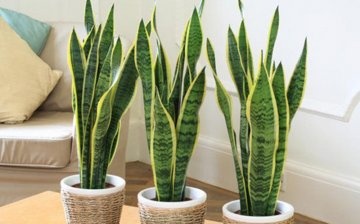
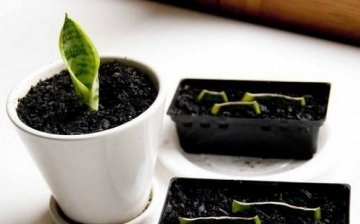

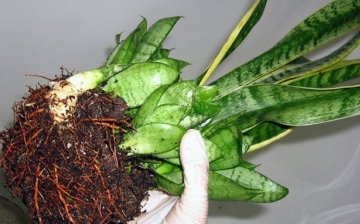








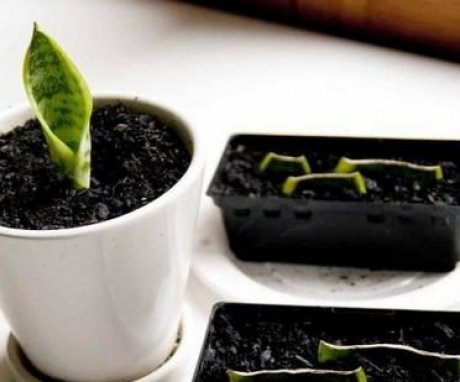
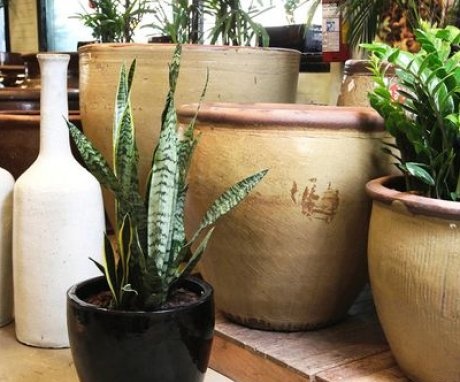
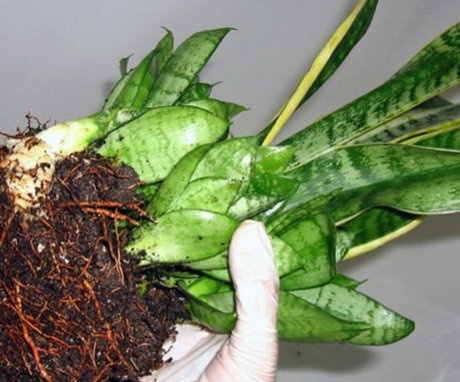
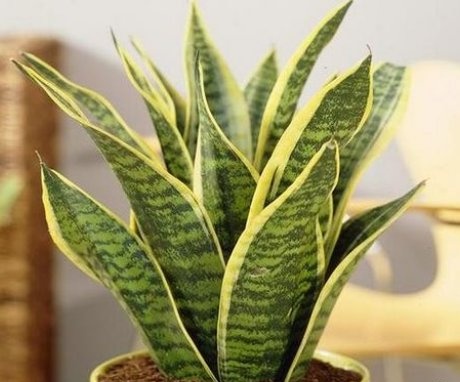
I love sanseviers! Simple and unpretentious plants that are easy to care for. They look good on floors in ceramic pots. The main thing is not to forget to wipe the leaves and water at least once every two weeks.
It is not a very whimsical plant. Suitable for too busy housewives who do not like to fiddle with flowers for a long time. They poured it once a week and forgot it. Growing staggeringly fast. I only had time to uproot the lateral children and give them to my friends. Minus - does not bloom.